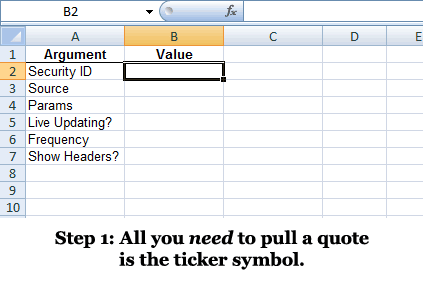using System;
using System.Collections.Generic;
using System.Reflection;
using System.Runtime.InteropServices;
using System.Threading;
using ExcelDna.Integration;
public static class ResizeTest
{
public static object MakeArray(int rows, int columns)
{
object[,] result = new string[rows, columns];
for (int i = 0; i < rows; i++)
{
for (int j = 0; j < columns; j++)
{
result[i,j] = string.Format("({0},{1})", i, j);
}
}
return result;
}
public static object MakeArrayAndResize(int rows, int columns)
{
object result = MakeArray(rows, columns);
return XlCall.Excel(XlCall.xlUDF, "Resize", result);
}
}
public class Resizer
{
static Queue<ExcelReference> ResizeJobs = new Queue<ExcelReference>();
public static object Resize(object[,] array)
{
ExcelReference caller = XlCall.Excel(XlCall.xlfCaller) as ExcelReference;
if (caller == null)
return array;
int rows = array.GetLength(0);
int columns = array.GetLength(1);
if ((caller.RowLast - caller.RowFirst + 1 != rows) ||
(caller.ColumnLast - caller.ColumnFirst + 1 != columns))
{
EnqueueResize(caller, rows, columns);
AsyncRunMacro("DoResizing");
return ExcelError.ExcelErrorNA;
}
return array;
}
static void EnqueueResize(ExcelReference caller, int rows, int columns)
{
ExcelReference target = new ExcelReference(caller.RowFirst, caller.RowFirst + rows - 1, caller.ColumnFirst, caller.ColumnFirst + columns - 1, caller.SheetId);
ResizeJobs.Enqueue(target);
}
public static void DoResizing()
{
while (ResizeJobs.Count > 0)
{
DoResize(ResizeJobs.Dequeue());
}
}
static void DoResize(ExcelReference target)
{
try
{
XlCall.Excel(XlCall.xlcEcho, false);
string formula = (string)XlCall.Excel(XlCall.xlfGetCell, 41, target);
ExcelReference firstCell = new ExcelReference(target.RowFirst, target.RowFirst, target.ColumnFirst, target.ColumnFirst, target.SheetId);
bool isFormulaArray = (bool)XlCall.Excel(XlCall.xlfGetCell, 49, target);
if (isFormulaArray)
{
object oldSelectionOnActiveSheet = XlCall.Excel(XlCall.xlfSelection);
object oldActiveCell = XlCall.Excel(XlCall.xlfActiveCell);
string firstCellSheet = (string)XlCall.Excel(XlCall.xlSheetNm, firstCell);
XlCall.Excel(XlCall.xlcWorkbookSelect, new object[] {firstCellSheet});
object oldSelectionOnArraySheet = XlCall.Excel(XlCall.xlfSelection);
XlCall.Excel(XlCall.xlcFormulaGoto, firstCell);
XlCall.Excel(XlCall.xlcSelectSpecial, 6);
ExcelReference oldArray = (ExcelReference)XlCall.Excel(XlCall.xlfSelection);
oldArray.SetValue(ExcelEmpty.Value);
XlCall.Excel(XlCall.xlcSelect, oldSelectionOnArraySheet);
XlCall.Excel(XlCall.xlcFormulaGoto, oldSelectionOnActiveSheet);
}
bool isR1C1Mode = (bool)XlCall.Excel(XlCall.xlfGetWorkspace, 4);
string formulaR1C1 = formula;
if (!isR1C1Mode)
{
formulaR1C1 = (string)XlCall.Excel(XlCall.xlfFormulaConvert, formula, true, false, ExcelMissing.Value, firstCell);
}
object ignoredResult;
XlCall.XlReturn retval = XlCall.TryExcel(XlCall.xlcFormulaArray, out ignoredResult, formulaR1C1, target);
if (retval != XlCall.XlReturn.XlReturnSuccess)
{
firstCell.SetValue("'" + formula);
}
}
finally
{
XlCall.Excel(XlCall.xlcEcho, true);
}
}
private static readonly TimeSpan BackoffTime = TimeSpan.FromSeconds(1);
static void AsyncRunMacro(string macroName)
{
Thread newThread = new Thread( delegate ()
{
while(true)
{
try
{
RunMacro(macroName);
break;
}
catch(COMException cex)
{
if(IsRetry(cex))
{
Thread.Sleep(BackoffTime);
continue;
}
return;
}
catch(Exception ex)
{
return;
}
}
});
newThread.Start();
}
static void RunMacro(string macroName)
{
object xlApp;
try
{
object xlApp = ExcelDnaUtil.Application;
xlApp.GetType().InvokeMember("Run", BindingFlags.InvokeMethod, null, xlApp, new object[] {macroName});
}
catch (TargetInvocationException tie)
{
throw tie.InnerException;
}
finally
{
Marshal.ReleaseComObject(xlApp);
}
}
const uint RPC_E_SERVERCALL_RETRYLATER = 0x8001010A;
const uint VBA_E_IGNORE = 0x800AC472;
static bool IsRetry(COMException e)
{
uint errorCode = (uint)e.ErrorCode;
switch(errorCode)
{
case RPC_E_SERVERCALL_RETRYLATER:
case VBA_E_IGNORE:
return true;
default:
return false;
}
}
}
